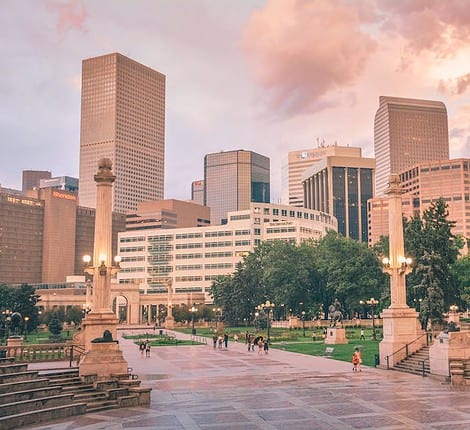Families First Coronavirus Response Act Employer FAQs
The “Families First Coronavirus Response Act” (H.R. 6201) has passed the Senate and been signed by President Donald Trump. It goes into effect on April 2, 2020. The Colorado Department of Labor has a notice for employers that you can find here that is being updated.
The Act was revised slightly from the bill passed by the House of Representatives on March 14, 2020. These provisions will apply from the effective date through December 31, 2020.
The U.S. Department of Labor (“DOL”) regulations are allowed to exempt small businesses with fewer than 50 employees from both of these provisions when the provision would jeopardize the viability of the business as a going concern. The DOL intends to issue emergency guidance and rulemaking that clearly articulates the standard for this exemption. During the DOL Virtual Town Hall on March 20, 2020, many small businesses requested that the DOL adopt a streamlined process for small businesses to apply for this exemption. We know you want more information and don’t want to wait a year for tax credits so we are watching this closely and will try to update with information as we get it.
WHAT DOES THIS MEAN AND WHO DOES IT COVER?
So there are two parts to this Act. The first is the FMLA leave provision and the second is the Emergency Sick Leave provision. We will address the FMLA provision first.
It means employees of employers with fewer than 500 employees, who have been on the job for at least 30 days, have a right to take job-protected leave under FMLA for up to 12 weeks if they meet the following conditions:
WHAT HAPPENS WHEN AN EMPLOYEE RETURNS TO WORK?
Employers generally need to restore an employee to the position held or its equivalent when the employee returns from leave; however, an exception exists for employers with fewer than 25 employees if certain conditions are met.
Remember the U.S. Department of Labor has the authority to exempt from the paid family leave requirement employers with fewer than 50 employees if the requirement to provide leave would jeopardize the viability of the business.
WHAT DOES AN EMPLOYER NEED TO PROVIDE UNDER THE PAID SICK LEAVE PROVISION?
Employers with fewer than 500 employees must provide employees with two weeks of paid sick leave that is:
IS THERE A DIFFERENCE BETWEEN PART-TIME AND FULL-TIME EMPLOYEES?
Full-time employees can receive up to 80 hours of sick leave, while part-time employees are eligible for leave based on their scheduled or normal work hours in a two-week period.
IS THERE A CAP ON THE SICK LEAVE?
Paid sick leave is calculated based on the employee’s regular compensation but is capped at $511 per day for employees who are subject to quarantine, has been advised to self-quarantine, or is experiencing symptoms. The Cap is at $200 per day for those in the two care-related categories.
ARE THERE ANY EXCEPTIONS?
Employers of health care providers or emergency responders may elect out of providing paid family leave to these employees.
DOES THIS CARRY OVER FROM ONE YEAR TO THE NEXT?
No, Paid sick time does not carry over from one year to the next.
CAN I REQUIRE MY EMPLOYEE TO FIND A REPLACEMENT TO COVER THEIR HOURS?
No, Employers cannot require employees to find a replacement to cover the hours during which the employee is using paid sick time.
WHAT IF I ALREADY HAVE EXISTING LEAVE POLICIES?
Employers that already have existing paid leave policies must also provide employees with this emergency paid sick time and cannot require employee use other paid leave provided before using this paid sick leave.
DO I HAVE TO PUT UP A NOTICE OR POSTER OF SOME KIND?
Employers are required to provide notice, a model of which will be provided by the U.S. Department of Labor. This can be found here.
WHAT HAPPENS IF I DISCHARGE OR DISCIPLINE AN EMPLOYEE WHO TAKES LEAVE OR FILED A COMPLAINT?
Employers may not discharge, discipline or in any other manner discriminate against an employee who takes leave under the Act or who has filed a complaint or instituted any proceedings under or related to the Act, or who has testified or is about to testify in any proceedings under or related to the Act. An employer could be subject to civil penalties for a violation of paid sick leave requirements.
We know that is a lot of information and there are still many unknowns about this Act. If you have any questions, please feel free to contact us. We are here to help. You can book a free 15-minute phone consultation here.
The Act was revised slightly from the bill passed by the House of Representatives on March 14, 2020. These provisions will apply from the effective date through December 31, 2020.
The U.S. Department of Labor (“DOL”) regulations are allowed to exempt small businesses with fewer than 50 employees from both of these provisions when the provision would jeopardize the viability of the business as a going concern. The DOL intends to issue emergency guidance and rulemaking that clearly articulates the standard for this exemption. During the DOL Virtual Town Hall on March 20, 2020, many small businesses requested that the DOL adopt a streamlined process for small businesses to apply for this exemption. We know you want more information and don’t want to wait a year for tax credits so we are watching this closely and will try to update with information as we get it.
WHAT DOES THIS MEAN AND WHO DOES IT COVER?
So there are two parts to this Act. The first is the FMLA leave provision and the second is the Emergency Sick Leave provision. We will address the FMLA provision first.
It means employees of employers with fewer than 500 employees, who have been on the job for at least 30 days, have a right to take job-protected leave under FMLA for up to 12 weeks if they meet the following conditions:
- They are caring for a child (under the age of 18) if the school or place of care for the child has been closed, or the childcare provider of the child is unavailable, due to COVID19 precautions.
- The first 10 days of leave may be unpaid, though an employee could choose to use accrued vacation days, personal leave, or other available paid leave for unpaid time off. Following the 10-day period, employees would receive a benefit from their employers that will be at least two-thirds of their normal pay rate.
- The family leave pay is capped at $200 per day and $10,000 in total.
WHAT HAPPENS WHEN AN EMPLOYEE RETURNS TO WORK?
Employers generally need to restore an employee to the position held or its equivalent when the employee returns from leave; however, an exception exists for employers with fewer than 25 employees if certain conditions are met.
Remember the U.S. Department of Labor has the authority to exempt from the paid family leave requirement employers with fewer than 50 employees if the requirement to provide leave would jeopardize the viability of the business.
WHAT DOES AN EMPLOYER NEED TO PROVIDE UNDER THE PAID SICK LEAVE PROVISION?
Employers with fewer than 500 employees must provide employees with two weeks of paid sick leave that is:
- Paid at the employee’s regular rate if (in connection with COVID-19) the employee:
- is subject to a quarantine or isolation order;
- has been advised to self-quarantine;
- is experiencing symptoms; or,
- Paid at two-thirds the employee’s regular rate if (in connection with COVID-19) the employee:
- is on leave to care for an individual who is subject to an isolation order or who is a quarantined employee; or
- is on leave to care for a child (under the age of 18) if the school or place of care for the child has been closed or the childcare provider of the child is unavailable, due to COVID-19 precautions.
IS THERE A DIFFERENCE BETWEEN PART-TIME AND FULL-TIME EMPLOYEES?
Full-time employees can receive up to 80 hours of sick leave, while part-time employees are eligible for leave based on their scheduled or normal work hours in a two-week period.
IS THERE A CAP ON THE SICK LEAVE?
Paid sick leave is calculated based on the employee’s regular compensation but is capped at $511 per day for employees who are subject to quarantine, has been advised to self-quarantine, or is experiencing symptoms. The Cap is at $200 per day for those in the two care-related categories.
ARE THERE ANY EXCEPTIONS?
Employers of health care providers or emergency responders may elect out of providing paid family leave to these employees.
DOES THIS CARRY OVER FROM ONE YEAR TO THE NEXT?
No, Paid sick time does not carry over from one year to the next.
CAN I REQUIRE MY EMPLOYEE TO FIND A REPLACEMENT TO COVER THEIR HOURS?
No, Employers cannot require employees to find a replacement to cover the hours during which the employee is using paid sick time.
WHAT IF I ALREADY HAVE EXISTING LEAVE POLICIES?
Employers that already have existing paid leave policies must also provide employees with this emergency paid sick time and cannot require employee use other paid leave provided before using this paid sick leave.
DO I HAVE TO PUT UP A NOTICE OR POSTER OF SOME KIND?
Employers are required to provide notice, a model of which will be provided by the U.S. Department of Labor. This can be found here.
WHAT HAPPENS IF I DISCHARGE OR DISCIPLINE AN EMPLOYEE WHO TAKES LEAVE OR FILED A COMPLAINT?
Employers may not discharge, discipline or in any other manner discriminate against an employee who takes leave under the Act or who has filed a complaint or instituted any proceedings under or related to the Act, or who has testified or is about to testify in any proceedings under or related to the Act. An employer could be subject to civil penalties for a violation of paid sick leave requirements.
We know that is a lot of information and there are still many unknowns about this Act. If you have any questions, please feel free to contact us. We are here to help. You can book a free 15-minute phone consultation here.




